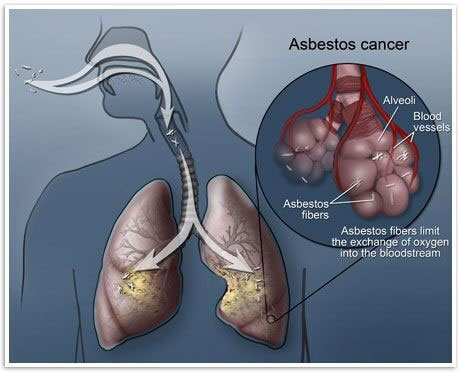WHAT IS ASBESTOS?
Asbestos is a naturally occurring mineral, which is fibrous in nature. Asbestos is found in veins surrounded by other rock. The vein consists of bundles of fibres held together reasonably firmly to form a solid rock. Mechanical milling breaks the fibres away from each other, leaving free fluffy fibres. Further mechanical action can break the fibres down into finer and finer fibres. This is because asbestos tends to break along the length of the fibre, not across the length of the fibre. Asbestos fibres can be extremely fine, with fibre diameters smaller than a micrometre (one one-thousandth of a millimetre) being fairly common.
Although there are about a dozen asbestos minerals, only three were in widespread use in Australia. These were:

- chrysotile, or white asbestos This has soft, white curly fibres and was the type in most common use;

- amosite, or brown asbestos. This has straight, harsh grey to brown fibres and was often used in situations where additional strength was required, such as in the manufacture of asbestos-cement pressure pipes; and

- crocidolite, or blue asbestos. This has straight, blue fibres, and the fibres tend to be very fine. Blue asbestos tends to have been used in situations in which acid resistance was particularly needed.
ASBESTOS USAGE
Asbestos became a popular commercial building product because it is non-combustible, resistant to corrosion, has a high strength and low electrical and thermal conductivity. Since the 1900’s asbestos fibres have been mixed with various binding materials to create an estimated 3,000 different commercial products. The amount of asbestos contained in these products ranges from 1 to 100 percent. Common building materials that may contain asbestos include:
HEALTH RISKS

Is Asbestos Dangerous?
Asbestos has been shown to cause cancer of the lung and stomach according to studies of workers and others exposed to asbestos. There is no level of exposure to asbestos fibres that experts can assure is completely safe.
Some asbestos materials can break into small fibres which can float in the air and these fibres can be inhaled. The tiny fibres are so small they cannot be seen with the naked eye. They can pass through the filters of normal vacuum cleaners and get back into the air. Once inhaled, asbestos fibres can become lodged in tissue for a long time. After many years cancer or mesothelioma can develop.
Are All Products With Asbestos A Health Risk?
No. A health risk exists only when asbestos fibres are released from the material or product. Soft, easily crumbled asbestos containing material has the greatest potential for asbestos release and therefore has the greatest potential to create health risks.
Do All People Exposed To Asbestos, Develop Asbestos Related Disease?
Inhalation of asbestos fibres has been linked to three respiratory diseases – asbestosis, mesothelioma and lung cancer. Exposure may also relate to other cancers, however, there is no conclusive evidence to support this. The three identified diseases are characterised by long latency periods, that is, 20 – 40 years from exposure to the onset of disease. However many young people have died from asbestos disease, with the youngest being a 3 year old girl.
Asbestosis is a chronic lung disease that can lead to respiratory impairment and to diseases such as lung cancer. It results from the inhalation of asbestos fibres, which are deposited, in the lungs causing scar tissue. The pulmonary changes resulting from the scar tissue are irreversible. It has been found to occur in workers exposed to prolonged and heavy concentrations of asbestos fibres. Asbestosis cannot be effectively treated.
Mesothelioma is a rare cancer. There are two types of mesothelioma, pleural which is tumour of the lung or peritoneal, which is a cancer of the abdominal cavity. The higher the level of exposure the greater the risk of developing mesothelioma. However the level of exposure does not affect the length of the latency period, which is usually between 30 and 40 years, before the disease is identified. Mesothelioma cannot be effectively treated.
Lung cancer is not specifically associated with asbestos. Individual lung cancers caused by asbestos cannot be distinguished from those cancers that are caused by other agents such as tobacco smoke. While persons who have been exposed to asbestos who develop lung cancer are usually tobacco smokers, it is generally accepted that asbestos is capable of causing lung cancer, and the tumour may develop where there is no co-existing asbestosis. Lung cancer related to asbestos exposure usually has a latency period of 20 to 40 years between the first exposure and the onset of cancer.
Inhalation of airborne asbestos fibres can cause death and therefore concentrations of airborne asbestos are a risk, which must be controlled. Airborne asbestos fibres can result from:
- The release of asbestos fibres through renovation, maintenance or demolition
- Accidental contact with the asbestos material causing fibres to break free
- Failure to adequately maintain an asbestos material resulting in the release of asbestos fibres.
DEADLY STATISTICS
References:
Safe Work Australia August 2010
Asbestos.com
World Health Organisation July 2010

